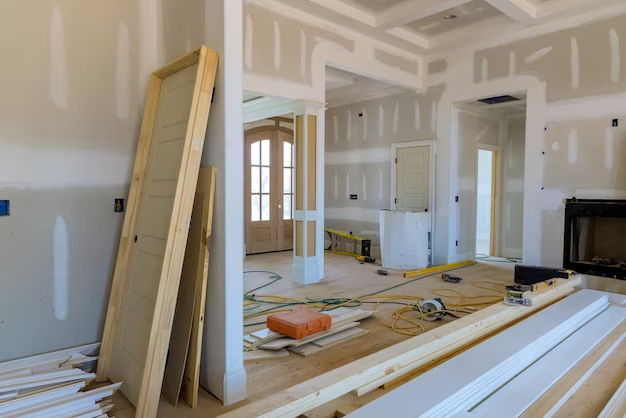|
Deciding Between Renovation and Relocation: Factors to Consider
Today, we delve into the analysis of the key factors when deciding between renovation and relocation. We’ll talk about how time, financial resources, and the state of the real estate market play a crucial role in this process. Considering these factors provides a deeper understanding of the practical aspects of this dilemma. It is also essential in creating a home that meets long-term needs and goals. So, let's move on to the aspects that will get you closer to making this decision! How much time do you really have? When making the decision between renovation and relocation, the role of time becomes very important. You need to consider how fast you want to achieve the desired changes in your living space. Renovation—while providing creative freedom to adapt to the current home—can require significant time for all phases of the process. It goes from initial planning through construction to the completion of the project. Understanding these chronological dynamics becomes crucial, especially if you have specific deadlines or want to make gradual, carefully thought-out changes in your living space. On the other hand, moving stands out as an option that allows for almost immediate changes, especially if you decide to hire an experienced professional to help you. This alternative becomes extremely attractive in situations where the speed of relocation becomes crucial. The analysis of time factors deeply shapes the decision between renovating and relocating, directing it toward your specific needs and goals within a certain time frame. What are your long-term plans and needs? Considering future plans and needs is unavoidable when deciding between renovation and relocation. Take the following into account:
How important are finances? In the process of deciding between renovating and moving, price plays a key role. Proper analysis of the financial aspects enables a realistic assessment of the feasibility of both options. So, if you are considering remodeling your home, here are some of the expenses you need to think about:
Balancing these factors against your budget and long-term goals is important. The best calculation comes from carefully comparing the total renovation costs with the moving costs. In addition to financial factors, it is important to consider emotional and practical aspects and long-term needs. Analyzing all these factors allows you to get the most out of every dollar invested and make an informed decision that reflects your goals, priorities, and possibilities. Which option brings ROI? A factor often overlooked in this dilemma is the return on investment (ROI), which carries the potential for long-term financial prosperity. Relocating Relocating may be a superior choice when the current property does not provide adequate value relative to the investment required to renovate. If extensive work is needed to adapt the home to needs and aesthetic standards, moving might enable the transition to a building with greater potential without the need for expensive and time-consuming renovations. Buying a new property in an area with a stable or growing market can result in a faster and higher return on investment compared to renovating an existing home. In short, moving can provide a more effective strategy for achieving a high ROI, especially when the real estate market is favorable and offers an opportunity to enter a space with potential for value growth. RenovatingRenovation is a better option when the existing home offers a strong foundation, and the necessary changes can be achieved through proper revitalization. If the value of the current property is greater than the renovation costs, there is an opportunity for a high return on investment. It is also possible that your current location has a bigger potential for future value growth. Renovation would be a smart decision in this situation because it would only strengthen this process. An emotional connection to the current home can also contribute to the decision to renovate, providing the satisfaction of remodeling a space according to personal preferences. Finally, deciding between renovation and relocation Deciding between renovation and relocation ultimately becomes more than just an immediate housing choice; it is a strategic step toward the future. Taking into account factors such as the current state of the market, financial aspects, and personal and family plans, you make a decision that shapes not only the present but also the long-term dynamics of your home. This approach allows you to meet current needs and create a home that will evolve with you, providing long-term harmony and functionality at every step of your life's journey. Meta Description: Discover the key factors when deciding between renovation and relocation, such as costs, timing, and plans. Author’s bio Zane Walter is a seasoned real estate expert and home improvement enthusiast with over a decade of experience in the industry. His insights are shaped by his passion for creating functional and aesthetically pleasing living spaces, along with a deep understanding of the real estate market trends. Zane's writing combines practical advice with a personal touch, aiming to empower homeowners to make informed decisions about their homes. https://www.pexels.com/photo/family-unpacking-after-moving-4569340/
0 Comments
 Alt tag: Tasks you need to tackle when selling your old home while purchasing a new one Navigating Dual Moves: Selling Your Old Home While Purchasing a New OneNavigating the real estate market involves selling your old home while purchasing a new one. This dual endeavor can be exciting and challenging, demanding careful planning and strategic decision-making. So, we'll walk you through the essential steps and considerations to make this complex process as smooth as possible! Assessing your financial situationAssessing your financial situation is pivotal when navigating the real estate market. Begin by examining your budget to determine how much you can comfortably allocate for a new house without straining your finances. Equally important is evaluating the equity you've built in your current property, which can significantly impact your purchasing power. Seeking pre-approval for a mortgage is a wise move, too, as it provides a clear picture of the loan amount you qualify for, allowing you to narrow your house search accordingly. By understanding your financial standing upfront, you'll be better prepared to make informed decisions and seize opportunities when selling your old home while purchasing a new one. Timing your sale and purchaseTiming your sale and purchase is crucial when selling your old home while purchasing a new one. After all, if you're moving from Florida to California and hiring movers to relocate from one coast to another, you must juggle many moving parties. Combine that with the stress of selling and buying a home, and timing is everything. Of course, even moves over a smaller distance require similar planning and care. You must carefully synchronize the sale of your property with the purchase of one to avoid gaps in housing. After all, having to rent temporary lodgings can get expensive! Contingency clauses can help align these transactions, but they require strategic negotiation. So, temporary lodging may still be necessary during this transitional period. Still, balancing these variables is key to a smooth transition. Preparing your old property for salePreparing your old property for sale is vital in achieving your ideal real estate journey. Conduct a thorough house inspection to identify and address any necessary repairs or maintenance issues. A well-maintained property can make a strong impression on potential buyers and increase its value. Consider staging your house to highlight its best features and create an inviting atmosphere. That can significantly improve its marketability and help it stand out in a competitive market. Appropriately pricing your property is equally crucial, requiring research and consultation with your realtor to determine the best quote. By preparing your old property, you pave the way for a smoother selling process. Marketing and listing your homeEffectively marketing and listing your property is pivotal when selling your old home and purchasing a new one. It's crucial to harness both online and traditional marketing channels to capture the attention of potential buyers. Collaborate with a reputable real estate agent who can craft a compelling listing highlighting your home's unique features and benefits. High-quality photographs and virtual tours can also give prospective buyers an immersive experience, driving interest in your property. Additionally, consider hosting open houses to allow buyers to explore your home firsthand and ask questions. Remember, the first impression matters, so enhance your home's curb appeal by maintaining the exterior, landscaping, and front entry. That will entice potential buyers even before they step inside. Effective marketing and listing strategies are key to attracting buyers and securing a successful sale! Negotiating offers and contractsNegotiating offers and contracts is a critical phase in the real estate process. When offers start coming in, it's essential to evaluate them carefully, considering the price and any contingencies and terms. Your real estate agent can be valuable in this process, helping you negotiate the best deal possible. Be prepared for some back-and-forth as you and the buyer work toward mutually agreeable terms. The contract will be drawn up once you've settled on an offer. Reviewing this contract is vital, ensuring all agreed-upon terms are accurately reflected. Any discrepancies or concerns should be addressed and resolved promptly. Remember, the contract is legally binding, so understanding it fully is crucial. The closing process for your old homeThe closing process for your old home marks the culmination of your selling journey. This phase involves several critical steps, including a final walkthrough to ensure the property's condition matches the agreed-upon terms. Be prepared for various documents and signatures, such as the deed, title transfer, and mortgage settlement statement. Your real estate agent and the closing agent will guide you through the paperwork, explaining each document's significance. During this time, you'll also settle any outstanding fees, including commissions and taxes. Financing your new homeFinancing your new home is, naturally, of critical influence. So, you must thoroughly explore your mortgage options to secure the best deal. That includes understanding the different types of mortgages available, such as fixed-rate and adjustable-rate mortgages, and their associated interest rates. Locking in a favorable interest rate is paramount to long-term financial stability. During the approval process, lenders will assess your credit score, income, and debt-to-income ratio, so maintaining strong financial health is essential. Meeting lender requirements, including providing necessary documentation and information, is needed to ensure a smooth loan approval process. By carefully navigating the financing process, you'll secure your dream home and a sustainable and manageable financial future. Remember, each step in securing your new home contributes to a successful homeownership experience, so approach it carefully and carefully. Coordinating closing datesCoordinating closing dates is critical to juggling a real estate sale and purchase. Aligning the closing date of your old home with the purchase of your new one can help prevent the stress of owning two properties simultaneously or experiencing a gap in housing. This strategic synchronization ensures a smoother transition. It also provides you with the flexibility to manage moving logistics more efficiently. For instance, the advisors from City Movers Miami point out that this would also make it easier to slowly transition your belongings from your old to your new home. Coordinating closing dates might involve negotiation and flexibility, but it's well worth the effort to streamline your move and minimize disruptions to your daily life. By planning and working closely with your real estate agent and all parties involved, you can navigate this process successfully, helping you transition seamlessly to your new home! A successful dual moveUltimately, selling your old home while purchasing a new one may seem daunting. However, it can be a rewarding journey with the right knowledge and guidance. You can confidently navigate the real estate market by following the steps we outlined! So, nothing is stopping you from tackling this process successfully. Author Bio: Introducing Sebastian Montclair, a seasoned real estate agent with over a decade of experience in the industry. With a keen eye for detail and a passion for helping clients find their dream homes, Sebastian has a proven track record of delivering exceptional results. His in-depth market knowledge and dedication to client satisfaction make him the go-to expert for anyone navigating the real estate landscape. So, you can trust Sebastian Montclair to guide you through your next real estate journey with professionalism and expertise! Meta Description: Check out our guide on selling your old home while purchasing a new one so you can properly prepare for the challenges of this process! Keywords: Selling your old home while purchasing Picture Link: https://pixabay.com/illustrations/real-estate-icons-marketing-home-2081571/ The moment you set foot in California, you're immediately drawn to the undeniable allure of West Coast living. From the stunning coastline to the vibrant cities, there's something undeniably magical about the lifestyle here. But how can you capture those coveted West Coast vibes in your new California home? This guide will take you on a journey to infuse your living space with the essence of West Coast living. It’s important to note that moving to California isn't just about geography; it's a state of mind, a unique way of approaching life that blends relaxation with ambition, nature with innovation, and community with individuality. It's a lifestyle that celebrates the outdoors, sustainability, wellness and the rich tapestry of cultures that call this place home. In your pursuit of happiness on the West Coast, your home becomes a dwelling and a reflection of your values and aspirations.
First Step- A Smooth Transition to Your New Home Embracing the West Coast vibes in your new California home begins with a successful, well-organized move to the Golden State. Moving to California from other states, particularly those on the East Coast, like Florida, requires meticulous planning. That’s why when you decide to relocate here from the East Coast, out-of-state movers become invaluable partners in ensuring a seamless transition. A successful relocation sets the tone for your new experience, allowing you to focus on adapting to the lifestyle and surroundings without the stress of a disorganized move. It's the crucial first step in your journey toward fully immersing yourself in the California way of life. So, before you start exploring the coastline or redecorating your home, ensure your relocation is smooth and hassle-free, paving the way to embrace those enticing West Coast vibes. Design Your Space- Incorporate the West Coast Vibes in Your New California Home When immersing yourself in the West Coast lifestyle, interior design plays a pivotal role. The first step is to incorporate natural materials and textures that evoke the rugged beauty of the coastline. Think reclaimed wood, stone, and cozy textiles. An open floor plan is another key element, allowing for a seamless flow between indoor and outdoor spaces. Coastal colors like serene blues and sandy neutrals can tie your decor together, echoing the colors of the Pacific Ocean. Outdoor Living Outdoor living is synonymous with California. Create an outdoor oasis to truly incorporate those vibes in your new home. Invest in comfortable outdoor furniture and lush landscaping, transforming your yard into a serene retreat. Take advantage of the pleasant climate by engaging in outdoor activities, whether hiking or simply lounging by the pool. The goal is to blur the lines between your indoor and outdoor spaces, making nature an integral part of your daily life. Sustainable Living California's commitment to sustainability is a core part of its identity. To fully immerse yourself in this new environment, you should adopt eco-friendly practices. Consider installing solar panels, using energy-efficient appliances, and minimizing water usage. Composting and recycling are essential habits contributing to the state's green ethos. By reducing your carbon footprint, you align with the lifestyle and contribute to preserving its breathtaking natural beauty. Health and Wellness In West Coast living, health and wellness occupy a central role, serving as pillars of this lifestyle. Prioritizing your well-being becomes an essential step on this exhilarating journey. The diverse landscapes offer a bounty of opportunities for outdoor exercise, whether you prefer practicing yoga on the sun-kissed beach or embarking on invigorating trail runs through the majestic mountains. Beyond the physical aspects, California living places great emphasis on mental health, with meditation and mindfulness practices woven into the fabric of daily life. These techniques provide solace and balance amidst the bustling pace of existence. Moreover, the commitment to a healthier lifestyle extends to its culinary offerings. The state boasts abundant organic and locally sourced food options, readily available to nourish your body with the freshest and healthiest ingredients. Community and Social Life California isn't just a place to reside; it's a vibrant and interconnected community waiting to welcome you with open arms. One of the standout aspects of living here is the diverse social scene. It's where you can effortlessly find your tribe, whether interested in art, music, sports, or cuisine. Engaging in local events, attending cultural festivals, and participating in community projects are excellent ways to integrate into this dynamic social fabric. From farmers' markets to street fairs, California offers many opportunities to mingle with fellow residents and visitors. And the beauty of social life in Cali is that it encourages exploration. Whether in a bustling city or a tranquil coastal town, something exciting is always happening around you. Embracing the Coastal SpiritThe California coastline exudes an irresistible charm and invites you to connect with the sea. Beach outings, water sports, and coastal hikes are your ticket to experiencing the coastal spirit. The sound of crashing waves and the salty breeze will become part of your daily soundtrack. Allow natural beauty to immerse you in the serenity and freedom of coastal living. Balancing Work and Play Balancing work and play is a crucial aspect of the California lifestyle. Exploring remote work opportunities and flexible schedules to integrate into this community fully. Embrace the concept of "bleisure" (business + leisure) by blending your work responsibilities with recreational activities. Whether working from a beachside cafe or taking midday breaks for a quick surf, California encourages you to find harmony between your professional and personal life. In Conclusion In conclusion, embracing the West Coast vibes in your new California home is a transformative journey. It's about more than just where you live; it's about how you live. By incorporating natural elements, prioritizing sustainability, and immersing yourself in the outdoor and social experiences, you can truly capture the essence of West Coast living. So, go ahead and infuse your new home with the magic of California—you won't just live here; you'll thrive here. Welcome to the West Coast. Author bio: Sophia Miller is an LA-based writer and lifestyle enthusiast. When not exploring the California coastline or seeking inspiration in local communities, you can find her crafting words to inspire and guide others on their journey to a fulfilling West Coast lifestyle. Meta: Learn how to capture West Coast vibes in your new California home with our comprehensive guide to coastal living. Kw- West Coast vibes in your new California home Image used: https://www.pexels.com/photo/city-near-mountain-during-golden-hour-2525903/ Golden State dreaming? You're not alone. Indeed, many find California's diverse landscapes and cultural vibrancy irresistible. Yet, venturing into California's real estate market, especially from out-of-state, can be daunting. Firstly, the terrain varies from bustling tech hubs to tranquil coastal escapes. Secondly, market dynamics change rapidly, often leaving potential buyers overwhelmed.
Furthermore, legal nuances and environmental risks unique to the state warrant attention. But fear not! With the right guidance, navigating this market can be a rewarding journey. Let’s embark on this adventure and unravel the secrets to making the Golden State your home. Understanding California's Diverse Regions The Golden State's charm lies in its diversity. Coastal cities buzz with life, offering iconic sea views. Conversely, inland regions beckon with affordability and space. Suppose you're moving from Miami to California. In that case, you'll notice the stark contrast between Hollywood's glamor and Gold Country's serenity. Meanwhile, tech giants dominate areas like Silicon Valley. On the other hand, the Central Coast presents a relaxed vibe reminiscent of a world untouched. Each region in California boasts a unique allure, and understanding these nuances is pivotal for a seamless transition into your new West Coast haven. Key Considerations for Out-of-State Buyers Navigating California's real estate market is more intricate than it might initially seem. First and foremost, it's imperative to delve into the state's legalities. California boasts distinct property tax regulations, especially Proposition 13, which could reshape your financial strategies. Are you setting up a residency? Know that California has unique guidelines, making it distinct from other states. Then, there are the ever-evolving market dynamics to comprehend. Real estate in the Golden State is notoriously fluid, often catching buyers off-guard. It's vital to grasp these market cycles to optimize your investment. Equally crucial is undertaking local market research; it offers invaluable insights and equips you to make prudent choices. California's myriad natural challenges, like earthquakes, wildfires, and occasional floods, necessitate comprehensive insurance coverage. As you delve deeper, you might notice a surge in virtual home tours, a testament to the state's forward-thinking approach. However, while they offer a glimpse, physically visiting a potential home gives insights no virtual tour can. These nuances, these small yet pivotal aspects, often influence the final choice in the property hunt. Finding a Local Real Estate Agent: Why It's Crucial Are you embarking on a West Coast adventure? Teaming up with a local real estate agent is paramount, especially for navigating California's intricate housing landscape. They provide the edge in competitive markets, ensuring your offer stands out. Furthermore, these experts have insider knowledge. They can guide you through bidding wars, ensuring you don't overpay or miss out. Also, when managing logistics for your move from Miami to California, an agent's connections can ease tasks, even recommending reliable interstate movers. Beyond this, a seasoned real estate agent can provide insights into neighborhoods, helping you find areas that align with your lifestyle and preferences. They can also assist in negotiating contract contingencies, ensuring that any potential issues like home inspections or financing terms are handled in your best interest. So, as you set your sights on the Golden State's shores, remember this: Local expertise isn't just beneficial; it's crucial. Enlist a local guide and simplify your Californian home-hunting journey. Financial Preparedness Are you stepping into the Golden State's property scene? Financial readiness is crucial. Start by acquainting yourself with the average home prices across California; the spectrum is vast, with some areas more upscale than others. Distinguish between pre-qualification and pre-approval; the latter's significance cannot be overstated in this vibrant market. Furthermore, having immediate access to funds accelerates the purchasing process. As you explore the myriad offerings of California's property landscape, a solid financial base is not just advisable; it's a necessity. By arming yourself with a robust financial strategy, your journey in this market becomes smoother. This foresight will be the bridge that turns your Californian aspirations into tangible reality. Embracing the Culture and Lifestyle As you move to the Golden State, it's not just about finding a home; it's about finding your community. First and foremost, California thrives on diversity. That means a tapestry of cultures is awaiting from San Diego's beaches to Napa Valley's vineyards. To truly belong, attend local events. They're gateways to the heart of a community. Additionally, seize networking opportunities. These can provide both personal and professional growth. On the other hand, leisure is equally vital. Explore the outdoors, indulge in local cuisine, and join community groups. Remember, assimilating into the unique lifestyle ensures a richer, more fulfilling experience. Embrace the change, and let the rhythm become your own. A Checklist for Out-of-State Buyers As you prepare to plunge into California's real estate market, having a checklist can be a game-changer. Firstly, schedule a final walk-through of the property. It ensures no last-minute surprises derail your purchase. Secondly, keep an eye on escrow and title services. Being out-of-state shouldn't slow down these critical steps. Furthermore, don't underestimate moving logistics. Planning is key whether relocating from a neighboring state or crossing the country. Lastly, tie up any legal loose ends. That includes finalizing tax matters and residency documents. By adhering to this checklist, you equip yourself for a smooth entry into the Golden State's diverse and dynamic housing market. Conclusion Embarking on a journey through California's real estate market can be both exhilarating and daunting. Yet, with preparation and insight, the Golden State's allure becomes more accessible. Each step is pivotal, from understanding diverse regions to selecting the right agent. Moreover, embracing the vibrant culture ensures a richer experience. In conclusion, while challenges abound in this market, they're surmountable with the right guidance. So, as you set your sights on the horizons, remember that your West Coast dream is well within reach with informed decisions and a spirited approach. Happy home hunting! Author BioAlexandra Hart is a seasoned blog writer with over a decade of experience in California's property market. She's authored numerous articles, providing invaluable insights to novice and seasoned buyers. Alexandra is passionate about demystifying the complexities of real estate transactions. Outside of work, she enjoys coastal hikes and California's sunsets. Focus keyphrase: California's real estate market Meta: Unlock the secrets of California's real estate market. Dive into tips, trends, and strategies for a successful home purchase. Photos used:  Although looks aren't everything, and the exterior of your home couldn't possibly tell buyers everything they need to know about it in a single glance: they will base a lot of their opinion on it on just those first few seconds. Instead of letting a lackluster exterior stop them from being interested, boost your house's value, and keep the HOA happy by kicking your curb appeal up a notch. These are the top renovations to boost your curb appeal dn give buyers a property they'll want to explore. 1. They Judge a Book By Its CoverOne of the main issues with drive-buy home buyers is that if they dislike any part of the exterior, it'll be harder to win them over on the interior of your property. It's vital that you stop and upgrade your porch and walkways as soon as possible. These are the first points of contact, and no buyer wants to feel like they’re walking into a project. Fix any cracks or lines in walkways and driveways, and deep clean your porch. Giving your front entrance a fresh coat of paint, and some cozy furniture, will change everything! 2. The Chance to Boost Native PlantsA green lawn can be beautiful, but it's not the easiest or most affordable thing to maintain for most homeowners. When buyers pull up to your property, if they see a lot of rare and complicated plants and a huge lush green lawn, they're going to make a few assumptions about how much this property needs in maintenance and water. If you're in an area where grass can't grow naturally, consider going for artificial turf, and make sure to invest in native plant species. Plants that grow naturally in your area will need less watering and care since they're built for this environment. 3. Investing In Outdoor Entertainment SpaceMore buyers are looking for outdoor entertainment space than anything else. They want an area where they can spend time with friends and loved ones and don't want to have to do that inside at all times. Adding a deck, patio, firepit, lounging area, or other outdoor space will give them a landing point for this idea. Instead of struggling to picture their life in this home, they'll know exactly what life would be like here. 4. Protecting From the Outside InMoisture will make its way into whatever properties it can, which will, in turn, damage the very foundation the house is sitting on. Instead of allowing that to happen, it's vital that you stop and plan out everything from waterproof moldings to moisture-resistant paint. Another important step is to ensure your roof and siding are new enough that they're not a threat to the buyer. The average roof will last from thirty to fifty years, and siding can last around twenty years. If these areas of your property are reaching their end, update before you list your home. 5. Understanding Different Siding TypesRegardless of whether you go for brick or steel siding, the choice you make will decide which buyers are interested in looking at your property. Although it can feel like a small choice, this will transform how your property is perceived by others. Different types of siding do better in other areas of the country. You won't find stucco siding in Maine for the same reason you're unlikely to find brick siding in Los Angeles. Consider what works in your environment. Even if you decide to go with a wood shingle, look at the shape and style that's big in your area. 6. Colors Can Do So Much For YouColor has a deep tie to our emotions and our rational thinking, which means you don't have to hunt for long online to find which colors leave the biggest impact. It's also vital to consider what's in style, what is popular in your area, and of course, what your HOA will allow. 7. How to Stand Out Without Being GarishIt's vital that you let your home stand out without being an eyesore. To do this, add trim, color, detail, and other small choices to set your building apart. Ensure that you don't overdo the details or add any colors or shapes that are too avant-garde compared to the rest of your neighborhood. You want your home to have charm. 8. Playing Into Your Home’s Style Before considering porcelain vs. concrete pavers, look at your home and figure out what style it is. There's nothing as unfortunate as someone trying to make a Victorian property look mid-century modern or turn a 1960s ranch-style home into something it isn't. Get to know the specific style of your home, and play off of that. Curb Appeal Renovations Should Be Your Next ProjectAlthough green grass is beautiful, there are countless other ways you can invest in creating fantastic curb appeal. Work with BL Real Estate Sales, and make your property one of the most attractive in your neighborhood.  Are you embarking on a long-distance move? Naturally, it's daunting. Fortunately, this guide to long-distance moving is here to help. First, we'll dive deep into planning and prepping. Then, we'll tackle the art of selecting reliable movers. Do you want to pack smartly? Covered! Plus, we'll touch on transitioning smoothly to your new locale. And, lest we forget, tips for transporting those special belongings. Finally, we'll discuss settling in. By the end, you'll have a treasure trove of strategies to navigate this big leap easily. Let's embark on this journey together. Ready? Planning and Preparation: Starting on the Right FootAre you diving into a move? Start strong. Begin preparations early; time is your ally. Draft a detailed moving timeline next. That ensures you don't miss key steps. Are you setting a realistic budget? Essential. It helps avoid unpleasant financial surprises later. And before you pack, take a moment. Consider decluttering. Get rid of what's unnecessary. In essence, a leaner move is often smoother. And remember, a well-planned start paves the way for a hassle-free transition. Equip yourself, streamline the process, and step forward confidently. Your moving adventure has just begun. Selecting the Right Moving Company: Trusting the Big MoveAre you selecting movers? It's a decision that demands diligence. First, dive into research. Seek recommendations, but don't stop there. Turn to online platforms like Verified Movers Reviews to find genuine feedback from real customers. Thus, you can gauge the company's reliability. Next, ask pointed questions. Find out about their insurance policies and delivery windows. Unexpected fees? Inquire about them too. An in-person quote can be a game-changer. It ensures accurate pricing and sidesteps potential scams. Remember, a reputable moving company can transform your experience. So, invest time in finding the right fit. After all, this move is a significant chapter in your life. Choose wisely and move with confidence. Packing Smart: Strategies for Efficiency and SafetyReady to pack? Let's master the art. Firstly, craft an 'essentials box.' It'll hold items you'll need immediately upon arrival. Think toiletries, chargers, and a change of clothes. Next, embrace the power of labels. By categorizing and marking boxes, you streamline the unpacking process. For your fragile treasures, employ bubble wrap and sturdy boxes. Delicate items demand extra care. When tackling clothes, consider varied solutions: wardrobe boxes for dresses and suits and vacuum bags for bulkier items. Additionally, a systematic approach ensures no essentials get overlooked. In essence, smart packing isn't just about fitting items into boxes. It's about efficiency, safety, and swiftly making your new place feel like home. Preparing for Life in a New Place: Adapting to ChangeStepping into a new place brings both excitement and apprehension. To make this transition smoother, our guide to long-distance moving emphasizes thorough research. Firstly, get acquainted with your community. Discover local amenities, schools, and hidden gems. Next, address the logistics. Promptly update utilities, subscriptions, and official documents. Moreover, it's crucial to recognize the emotional side. Moving can stir homesickness and a sense of displacement. So, engage in activities that ground you. Maybe join a community group or explore nearby parks. Essentially, adapting isn't just about logistics; it's an emotional journey too. As you settle, remember: every change offers opportunities. Embrace them wholeheartedly. Transporting Special Items: Pets, Plants, and ValuablesMoving isn't just about furniture and boxes. Special items require extra care. Firstly, let's talk about pets. Our furry friends can get stressed during relocations. So, ensure their comfort with familiar toys and timely breaks. For plants, hydration is key. Additionally, use open boxes to allow them to breathe. As for valuables like art and heirlooms, protective packaging is paramount. Bubble wrap, cushioned boxes, and careful labeling work wonders. Furthermore, consider insurance for high-value items, offering peace of mind. While every item in our home holds importance, some necessitate added attention. By catering to their specific needs, we pave the way for a seamless, stress-free move. Embrace these nuances, and watch your move unfold smoothly. Settling In: Making Your New Place HomeOnce moved, the real transformation begins. First, unpack the essentials. This initial step alleviates immediate stress. Next, personalize your space. Hang photos, add décor, and make it yours. Moreover, don’t delay in introducing yourself. Meeting neighbors fosters a sense of community. Engage, attend local events, and explore. By weaving into the local fabric, feelings of alienation dissipate. Indeed, turning a new house into a home is an art. It's a blend of the physical – arranging furniture – and the emotional – building connections. Dive in, and watch a mere place bloom into your sanctuary. Avoiding Common Pitfalls of Long-Distance MovingAre you navigating a long-distance move? Dodge common pitfalls. Firstly, resist the urge to overpack. Lighter loads simplify transit. Then, stay wary of last-minute changes; they can disrupt plans severely. Moreover, ensure important tasks aren't overlooked. From utility setups to school registrations, details matter. Additionally, avoid relying solely on memory. Instead, use checklists; they're lifesavers. And remember, while spontaneity has its charm, preparation reigns supreme in relocation. By sidestepping these frequent missteps, you ensure a smoother move and embark on this new chapter with greater confidence. Move smart, not hard! ConclusionIn wrapping up our journey, this guide to long-distance moving has offered a comprehensive roadmap for relocation. Every step holds importance, from the initial planning stages to the emotional task of settling in. And while challenges might arise, equipped with knowledge, they become surmountable. Moreover, remember that moving is not just about a physical transition. It's a transformative life experience. As you embrace this adventure, may this guide serve as a trusted companion, illuminating your path. Embrace the change, harness the knowledge, and embark confidently. Safe travels and joyful settling! Author BioJamie Mitchell is a relocation expert with over a decade of experience in the moving industry. Passionate about helping others navigate the challenges of moving, she shares invaluable insights and tips through her writing. Outside of work, Jamie enjoys hiking and exploring new cities. Focus keyphrase: Long-distance moving Meta: Unlock a smooth transition with our comprehensive guide to long-distance moving—expert tips and strategies for a hassle-free move. Photos used:  Empty nest refers to the transition many homeowners face when their children move out. Suddenly, that lively, bustling home feels spacious, perhaps even a bit too spacious. Navigating this new phase in life usually brings homeowners to a decision — whether to hold onto the memories or make a change. If you've been contemplating whether to sell your empty nest home, this article is poised to shed light on why doing so might be a wise choice. Financial Benefits 1 Reduce Maintenance Costs By Downsizing Firstly, a smaller home translates to savings in multiple ways. With fewer rooms to heat or cool, your utility bills take a noticeable dip. Less space also means reduced maintenance costs, saving you from expensive repairs and upkeep associated with larger homes. Think fewer roofs to fix, fewer windows to clean, and less lawn to mow. Every room you don't have translates to hours and dollars saved, allowing you to focus on enjoying life rather than being tied down by home chores. 2 Unlock Home Equity Understanding home equity is crucial for homeowners at this juncture. Essentially, equity represents the portion of your property you own— the difference between its market value and any outstanding mortgage or loan amounts. When you decide to sell your empty nest home, you unlock this equity, transforming it into tangible cash. This influx can be pivotal for various ventures, be it embarking on new experiences, investing elsewhere, or bolstering retirement funds. Selling liberates this dormant wealth, allowing you to utilize it more dynamically. 3 Potential for Profit The real estate market is often likened to a pendulum, constantly swinging between a buyer's and seller's market. At certain times, selling your property can be particularly lucrative. With your empty nest home, especially if it's in a desirable neighborhood or has unique features, you might be sitting on a goldmine. Additionally, the funds from the sale can be reinvested in a smaller, more affordable property, which, over time, might appreciate. Although you might experience some short-term home seller’s remorse in the beginning, selling now could set the stage for significant financial growth in the future. Embrace a Simpler Lifestyle 1 Less Cleaning and Upkeep A larger home often comes with a lengthy list of chores and responsibilities. The tasks can be endless, from sweeping vast floor areas to dusting multiple rooms. Opting for a smaller abode means less cleaning and upkeep. Imagine having fewer windows to wash, fewer rooms to vacuum, and more manageable space to maintain overall. With a compact living area, the time and effort spent on housework diminish, gifting you with more moments to relax, pursue hobbies, or simply savor the newfound simplicity. 2 Reduced Clutter Over the years, spacious homes tend to accumulate many items — from forgotten toys in the attic to stacks of old magazines in the basement. With children moving out and life evolving, decluttering becomes not just an option but a necessity. By selling your empty nest home and moving to a smaller space, you're naturally prompted to sift through belongings, determining what's essential and what can be let go. This process clears physical space and mentally declutters, paving the way for a more organized and serene environment. As primelinevanlines.com notes, a common practice for homeowners who want to keep sentimental items without cluttering up their homes is to find a local storage unit and store them away there. 3 Easier to Manage When we discuss home management, we aren't just referring to tangible chores. A larger home often carries unseen responsibilities: tracking repairs, coordinating home improvements, and juggling multiple rooms' needs. Downsizing to a more compact residence inherently simplifies these tasks. It’ll even be easier to boost and maintain your smaller home’s curb appeal. There's less to monitor, fewer areas demanding attention, and a general ease in handling day-to-day affairs. This streamlined approach to home management alleviates stress and gives homeowners a sense of lightness and freedom in their daily lives. Location Freedom 1 Opportunity to Relocate Life is marked by chapters, and with an empty nest, a fresh chapter beckons. One of the most exhilarating prospects at this juncture is the freedom to relocate. Perhaps you've dreamed of living in a vibrant urban hub such as LA. While moving to a new area like that can sometimes feel intimidating, as long as you engage pros in the process to help you move your possessions, it can be done smoothly and swiftly. Selling your current home presents a golden ticket to explore these dreams. 2 Downsize to a More Suitable Environment A sprawling family home, while perfect for raising children, might not cater to the current rhythm of your life. As phases shift, so too do our spatial needs and lifestyle preferences. Downsizing is not merely about moving to a smaller space but also about aligning with an environment that mirrors your present-day desires and necessities. Perhaps you're seeking quieter neighborhoods, proximity to specific amenities, or a more tight-knit community vibe. Choosing to sell your empty nest home allows you to select a tailor-made locale for your new chapter. 3 Better Amenities and Conveniences The surroundings of a home play an immense role in daily contentment. While a large, secluded property might have been ideal during child-rearing years, now, accessibility to amenities might take precedence. Selling your empty nest home can position you closer to conveniences like health centers, shopping malls, or cultural hubs. Transitioning to a new locale can also offer new social opportunities, as your neighbors can affect everything from your home sale to your overall living experience. Preparing for the Future 1 Retirement Planning As the horizon of retirement approaches, financial prudence becomes paramount. Once teeming with life, the family home might now seem oversized and burdensome in terms of upkeep and finances. By selling, you can effectively integrate this substantial asset into your retirement strategy. The proceeds from the sale can bolster retirement funds, be invested for consistent returns, or even finance a more affordable and manageable residence. It's a proactive step, ensuring comfort and financial stability in the golden years ahead. 2 Legacy Planning Legacy planning is about thoughtfully preparing for the future, ensuring the well-being of loved ones, and leaving behind a meaningful impact. The family home is a significant asset, and its sale can be pivotal in this process. Whether you're thinking of creating educational funds for grandchildren, supporting charitable endeavors, or simply ensuring a comfortable financial cushion for future generations, selling the family home can provide the necessary liquidity. It's a conscious move that interweaves personal goals with long-term familial considerations. To Conclude In the intricate tapestry of life, change is the only constant. Our living spaces should adapt and reflect our evolving needs as we navigate various transitions. Deciding to sell your empty nest home is not just a real estate decision but a proactive step towards optimizing the quality of life, financial health, and future planning. It’s about carving a path that resonates with current aspirations while laying the foundation for future endeavors. Embrace the possibilities and let your home be a bridge to new horizons. Author’s Bio: John Russell is a real estate agent and freelance writer. He loves to help people find their dream homes while getting the best deals possible. Meta: From financial to lifestyle benefits, you should discover why it is a smart move to sell your empty nest home. Focus keyphrase: sell your empty nest home Photo used: https://unsplash.com/photos/XGvwt544g8k Renovations Made Easy: Step-by-Step Guide to Planning and Executing Your Dream Home Makeover8/4/2023 Renovations Made Easy: Step-by-Step Guide to Planning and Executing Your Dream Home Makeover
Renovations are equally stressful and exciting, but it can seem hard to pick where to start and what to do if you're new to them. Instead of winging it, you must have a plan in place so you don't waste money and effort. This is a step-by-step guide for planning and executing your dream home makeover, as well as some tips on avoiding wasteful mistakes. 1. Gather InspirationBefore you start your project, set a budget, or consider what you can DIY: knowing what you want to accomplish is vital. Use sites like Pinterest to create a wishlist of what you'd like to do for your home. Do you want to gut and remodel the kitchen? Are you trying to add an outdoor entertainment space? Look at photos for inspiration, and consider what would be physically possible for your home. 2. Understand What’s NecessarySome updates are more important than others, like adding soundproof panels, so it's vital to keep track of those. As fun as it is to think about all the things you want to do, make sure your needs are taken care of first. Things like your roof, siding, drainage, and more should all be considered first. If they don't need replacements, think about what maintenance might be necessary and what you can do to carry that out. Although it can feel like a lot at first, it's essential to keep your property value up. 3. Create a Realistic BudgetMost energy-efficient buildings can save the owners thousands a year in heating and cooling alone, but don't let that lure you into thinking you can spend whatever you want on this project. Saving money by going for products like wholesale flooring can take your home a long way. When building your budget, put the highest priority on your needs, and then assign a few of your wants, depending on what you can afford. Be realistic with what you can set aside money for, and set a little extra aside so that you don't have to stress if you get too close to your limit. 4. Keep a Notepad on HandWhen still in the planning stage for your home, take a notepad with you as you live your daily life. Writing down things you notice and want to update is a great way to ensure you can keep in mind what you want to change and what doesn't matter to you at all. Although you won't be able to complete everything you write down, it's a good way to ensure you don't forget anything you really want done until you're already over budget. 5. Consider What You Can DIYAlthough there are some projects and insulation tools the average homeowner can handle on their own, it’s not necessarily the best idea for most homeowners to attempt every project. Look at your history of DIY, and consider what updates and changes you've made on your own. This could mean painting, refinishing cabinets, updating hardware throughout your home, and even replacing lighting. If there's a project that feels outside of your wheelhouse, don't attempt it: you could be wasting money doing so. 6. Work With Pros to Complete the Rest Although making the decision on aluminum siding vs. vinyl siding is up to you: installing it shouldn't be in your hands. Take the time to shop around and find professionals who are within your budget while still offering the skills and abilities you want to use. Don't be afraid to interview multiple companies before you make your choice. Although this can feel like a lot, it's a good idea to find someone you can put your full trust in. 7. Deep Clean Before and AfterDeep cleaning before and after you do a large remodel is the best way to start and finish a project on the right foot. This will give you a clear view of what's needed and also let you feel like you're working with a fresh slate afterward! This will make the final product feel incredible and will boost the effect on buyers as well! 8. Keep Up With MaintenanceMaintenance is one of the most stressful things you can go through as a homeowner, so it's vital to plan ahead and set a schedule for yourself before you complete a remodel. Whether this means clearing your roof twice a year and checking its health, or it implies power washing your home's exterior every spring, set a schedule and stick to it. A well-maintained home will last longer and save you money. Every Home Makeover can be a Dream Come True. Your dream home isn't far away! Whether you're updating your property to sell or you want to make coming home far more exciting every day, follow these steps and work with BLRE Sales to boost your house to the next level! Selling a home can often feel like navigating a maze, especially when making your property appear as appealing as possible. It can be tempting to embellish certain aspects or even outright lie, but the truth holds incredible value. That is especially relevant when considering what homeowners wish they knew before buying. Therefore, discussing the things you shouldn't lie about when selling your home becomes crucial. Honesty is more than just morality; it's integral to a smooth, transparent, and successful home-selling process.
Top 5 Things You Shouldn't Lie About When Selling Your Home Lying or omitting critical information during the home-selling process isn't merely unethical; it's potentially illegal. Laws vary from place to place, but many jurisdictions require sellers to disclose potential problems or defects in the property fully. Failure to do so can lead to legal consequences such as rescission of the sale, damages for the cost of repairs, or in extreme cases, punitive damages for deceitful behavior. Indeed, dishonesty in home sales can lead to significant legal repercussions, as numerous instances of lawsuits and hefty penalties can attest. A striking example is a case in California where a couple faced $1.12 million in damages for failing to disclose a past landslide risk. The property was later deemed uninhabitable, underlining the grave consequences of untruthfulness. It is also crucial to understand the ways your neighborhood can affect your home sale. Therefore, honesty becomes indispensable, particularly the top 5 things you shouldn’t lie about when selling. Pest Infestations As with structural defects, revealing past or present pest infestations is non-negotiable. Pests such as termites, bed bugs, or rodents can significantly affect the home's value and livability. If the buyer discovers a pest problem after the sale, it can cause them financial and emotional distress. Therefore, you should communicate any history of pest infestations and measures taken to address the issue to prospective buyers. Home Repairs and Defects While it's crucial to be honest about home repairs and defects, it's also good practice to keep some things out of sight. That doesn't mean hiding defects but decluttering and storing personal items that might distract potential buyers. A clean, neutral space can help buyers envision themselves in the home, while too much personal clutter can detract from the property's appeal. Therefore, being upfront about any leaks, structural problems, or faulty wiring paired with a well-presented home can facilitate a smooth and successful home sale. Property Boundaries Accurate representation of property boundaries is another crucial factor in home sales. Misrepresentation can lead to disputes with neighbors and legal issues and affect the property's value and utility. That includes not only the size of the lot but also any easements, encroachments, or rights of way that might affect the property. Buyers should clearly understand what they're purchasing and how they can use it. A survey can be a useful tool to confirm property lines and avoid potential disputes. House HistoryBeing transparent about significant events in the house is essential when selling your home. Some jurisdictions require disclosing events like crimes or deaths on the property, as these could psychologically impact potential buyers. Even in places where the law doesn’t require such disclosure, it's good practice to be open about the home's history. Concealing these details might seem advantageous in the short term but can lead to serious repercussions if discovered later. Neighborhood Concerns When selling a home, it's not just about the property itself. The surrounding neighborhood plays a significant role in a buyer's decision. As a seller, it's your responsibility to disclose any concerns that might influence this decision. That could include high noise levels, planned construction projects, or issues with local schools. Not providing this information can leave buyers feeling misled and potentially result in legal troubles down the line. The Benefits of Honesty in Home Sales Embracing honesty, as suggested in any home seller's guide, offers numerous benefits and is the cornerstone of a successful selling strategy. It nurtures trust between you and potential buyers. Knowing they're dealing with an honest seller, buyers are more likely to feel confident about their decision and less inclined to withdraw from the deal. This trust not only smoothens the current sale but also helps build a positive reputation for you, which could influence future sales and recommendations. Secondly, being honest helps you avoid potential legal complications. As mentioned, hiding or lying about certain aspects of your home could lead to lawsuits or penalties. Being truthful from the outset eliminates this risk, ensuring a smoother transaction. Moreover, honesty provides peace of mind during and after the sale. You can rest assured knowing you have done the right thing without worrying about past dishonesties resurfacing and causing complications. Conclusion Honesty isn't just a virtue; it's a vital part of the home-selling process. You facilitate a more seamless and successful transaction by being open about the things you shouldn't lie about when selling your home, like home defects, house history, and neighborhood concerns. Remember, your integrity is key in this process. This practice will help build trust with potential buyers, safeguard you from legal issues, and give you peace of mind. Here's to selling your home with honesty, transparency, and success! Author’s Bio With over a decade in real estate, Glenda Smith is a seasoned professional and moving expert. She provides practical advice through her insightful articles, aiming to make real estate transactions smoother. Glenda champions honesty, transparency, and dedication to facilitating fair and successful property sales. KW: things you shouldn’t lie about when selling Meta Description: Discover why honesty is the best policy and learn about the things you shouldn't lie about when selling your home. Be a responsible seller! https://www.pexels.com/photo/white-and-brown-concrete-bungalow-under-clear-blue-sky-210617/  Featured Image Alt-tag: A woman experiencing stress because her neighbors are negatively affecting her home sale. Surprising Ways Your Neighbors Can Affect Your Home Sale When planning to sell your home, many factors come to mind – market trends, home improvements, pricing strategies, and more. However, one often overlooked element is the surprising ways neighbors can affect your home sale. While it might seem less significant, the impact of neighboring properties and the behavior of your neighbors can be profound. These factors can alter the perception of potential buyers and, consequently, the outcome of your sale. This extends beyond mere appearances. It involves a complex interplay of the social environment, property valuations, and even neighborly interactions during the sales process. From impacting your home's curb appeal to subtly swaying its market value, the role your neighbors play is multifaceted. This article delves into the often unexpected influence your neighbors can have on the success of your sale. We’ll offer an insightful exploration and practical strategies for leveraging these influences, helping you navigate your home-selling journey with an enlightened perspective and achieve a quick and smooth home sale. The Visible Impact of Neighbors on Your Home SaleFirst impressions have a lasting impact, particularly when it comes to property sales. It's crucial to understand that the general appearance of your home extends beyond its physical boundaries. It encapsulates the entire neighborhood, including the state of the neighboring properties. Imagine a potential buyer pulling up to your home. Even before they step inside your property, they take in the surroundings. Your home's curb appeal isn’t just about your manicured lawn or the fresh coat of paint on your walls. It extends to the neighbor's unkempt yard, peeling paint, or a rundown facade. These elements may lower your property's perceived value, even if your home is in impeccable condition. Conversely, if their homes are well-maintained, your neighbors can affect your home sale by significantly enhancing your property's appeal. Buyers don't just purchase a house; they buy into a neighborhood. A picturesque and well-kept neighborhood provides a desirable backdrop, fostering a positive impression and making your property more attractive. One thing to remember is that while thinking of how your neighbors can harm/help your sale, it’s important not to forget about your contributions. For example, experts from Best Movers in Florida recommend taking the time to declutter your home before putting it on the market by putting your possessions in a short-term storage unit while viewings are going on. The Social Influence of Neighbors on a Home SaleDelving into the societal dimension, neighbors' behavior and lifestyle can significantly sway a potential buyer's decision. The essence of any residential property extends beyond its four walls; it includes the wider living environment. Therefore, when buyers consider your home, they also contemplate the neighborhood's social fabric. Loud noises, frequent disturbances, or visible disputes can create an unappealing image. The promise of peaceful living is an enticing factor for buyers, and the disruption of this tranquility can act as a deterrent. Such factors can negatively influence A buyer's imagination, causing them to rethink their decision. On the other hand, warm and engaging neighbors can affect your home sale in a very positive manner. An inviting and friendly community can charm potential buyers. The prospect of forming pleasant social connections and becoming a part of a vibrant neighborhood can tip the scales in favor of purchase. Influence of Neighbors on Property PricingIn the intricate world of real estate, your neighbors can wield substantial influence over your property's pricing. This influence operates on multiple levels, and understanding its dynamics can prove beneficial when setting your home's selling price. One significant factor is the comparative market analysis. Real estate professionals use this tool to estimate a home's value by comparing it to similar nearby properties that have recently sold. Thus, the selling prices of neighboring homes can considerably sway your property's perceived value. Sellers need to stay abreast of the neighborhood's sales trends to avoid homeseller’s remorse. Furthermore, the reputation of your neighborhood is an important consideration. A neighborhood known for safety, good schools, or vibrant community life can command higher property prices. Conversely, an area plagued with problems can depress property values. How Your Neighbors Can Actively Help in Selling Your HomeWhile some of the ways neighbors can affect your home sale may be indirect or passive, there are also active ways in which they can contribute to your selling process. Harnessing these potential benefits can give you a distinct advantage in the competitive real estate market. A neighbor who takes pride in their home's appearance helps enhance the overall image of the neighborhood, potentially attracting more buyers to your property. They can also broaden your network by spreading the word about your property within their social circles, increasing the visibility of your listing. The moving process itself can be eased with the help of your neighbors. For instance, borrowing some must-have packing supplies can reduce moving costs. Using quality materials to simplify the process of moving will also give you some extra time to spend on the sale. Even during open houses, neighbors maintaining a clean and inviting exterior can add to the overall appeal of your home. Lastly, if you're fortunate, some neighbors may offer you temporary storage space, helping you declutter your home for viewings and emphasizing the supportive community the buyer can become part of. Expert AdviceNavigating the home sale process can be complex, and the influence of your neighbors adds another layer to this complexity. However, understanding these dynamics can equip you with the tools to manage this influence effectively. Engaging with your neighbors, communicating your plans, and seeking their cooperation can go a long way in presenting a harmonious neighborhood image. Remember, home selling isn't just about your property but also about the surrounding community. A neighborhood that’s welcoming and friendly is a valuable selling point. Hence, utilizing your neighbors' help can indeed improve your chances of a successful and quick home sale. Final ThoughtsSelling a home is no small feat. It involves numerous variables and influencing factors, some of which can be surprising. The ways neighbors can affect your home sale, for instance, often go unnoticed but can significantly sway the success of your home sale. From influencing curb appeal and property pricing to impacting the social atmosphere, neighbors can influence your home sale in ways you may not have previously considered. It's crucial to acknowledge and understand these influences. There are certain unwritten etiquette rules for sellers when it comes to involving neighbors in the selling process. These can range from maintaining open communication lines to requesting assistance during open houses. Implementing such measures can help ensure a smooth and successful sale, turning potential challenges into opportunities. In conclusion, your home sale is not an isolated event but a process intricately connected to your neighborhood's dynamics. Meta: Knowing the various ways your neighbors can affect your home sale is the first step in preventing certain issues that can come up during it. Focus keyphrase: neighbors can affect your home sale Photo used: https://unsplash.com/photos/bmJAXAz6ads Author’s Bio: Arthur Michaels is a real estate agent and freelance writer. He prides himself on his ability to match people with their dream homes and loves helping people get the best deals when making their dreams come true. |
Archives
July 2024
Categories |







 RSS Feed
RSS Feed